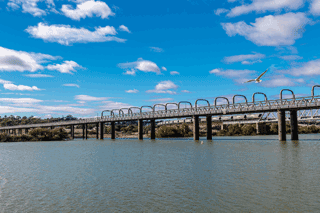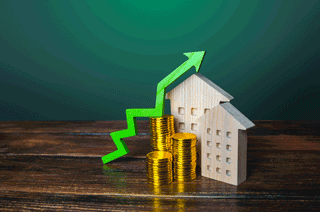Quote of the Week
“Those unsure about the way forward should not give up on their aspirations to own a house but could consider a variety of steps along the way. The journey to owning your forever home may take time and require trade-offs – options like buying an apartment, a duplex, a smaller house or even moving to a location slightly further afield to take that first step on to the property ladder.”
Great Southern Bank’s chief customer officer, Megan Keleher
Regions Lead 2022 Price Growth
 Regional Australia continued to outperform the capital cities in 2022, with dwelling values rising marginally last year in the Combined Regions, compared to a 6.9% decline in the Combined Capitals.
Regional Australia continued to outperform the capital cities in 2022, with dwelling values rising marginally last year in the Combined Regions, compared to a 6.9% decline in the Combined Capitals.
That’s according to CoreLogic data, which shows the Combined Regions recorded a 0.1% increase in dwelling values in 2022, helped by a 2.2% increase in regional apartment markets.
Across the house markets, the Combined Regions fell just 0.2% while the Combined Capitals decreased 7.4%. The outstanding house markets last year were in South Australia: the median price for Adelaide rose 9.6%, while Regional SA increased a nation-leading 17.7%.
Other markets to record annual increases in their median house prices included Perth (4%), Darwin (4.5%), Regional WA (5.6%), Regional Tasmania (3.1%), Regional Queensland (1.2%) and Regional Northern Territory (2.7%).
Among the unit markets, those to record annual growth in median prices included Brisbane (6.7%), Adelaide (14%), Darwin (4%), Perth (1.1%) Canberra (2.6%), Regional Queensland (4.5%), Regional SA (6.7%) and Regional WA (8.3%).
Rent Increases Push Up Yields
 A new report forecasts double-digit growth in rents this year for 11 of the 14 major residential markets across Australia.
A new report forecasts double-digit growth in rents this year for 11 of the 14 major residential markets across Australia.
Knight Frank’s Outlook Report 2023 says a combination of factors has resulted in a supply crunch that will help drive up rents: population growth has continued to add to demand, augmented by a rise in the proportion of households renting and a 17.8% decline in new dwelling construction.
Rental yields continued to rise towards the end of 2022. CoreLogic says the national gross rental yield for all dwellings was at 3.8% (4.5% for regional markets and 3.6% for capital cities).
CoreLogic’s Tim Lawless says: “Rental yields moved through record lows at the beginning of 2022 due to housing values rising at a faster pace than rents. Since then, gross yields have been on a rapid recovery trajectory.”
Rents rose 10.2% in 2022, rising across every broad region and housing type of the country. SQM Research records higher growth, with rents up 17%.
Falling Approvals Add to Shortage
 Further decreases in dwelling approvals are likely to exacerbate the shortage of homes which is pushing up rents.
Further decreases in dwelling approvals are likely to exacerbate the shortage of homes which is pushing up rents.
ABS data shows dwelling approvals recorded their third consecutive month of decline in November. The 9% decline in the number of dwellings approved follows a 5.6% fall in October. Overall, total dwelling approvals have fallen 22% since August.
Tasmania and South Australia have gone against the trend, reporting increases in approvals in November.
Daniel Rossi, ABS head of construction statistics, says the November result was driven by a 23% decrease in approvals for apartments, while approvals for houses fell 2.5%.
The value of total building approvals fell 1.5% in November, following a 0.4% decrease in October.
But the value of non-residential building approvals remained strong, increasing 2.0%, following a 2.3% rise in October.
Three months of falling home building approvals enhances the nation’s dwelling shortage, which is most evident in the rental markets, with vacancies 1% or lower in most parts of the nation.
Consumers Optimistic On Prices
 Australian consumers collectively have shrugged off the negative forecasts of economists, with a key consumer sentiment survey showing that more people expect house prices to rise than fall in 2023.
Australian consumers collectively have shrugged off the negative forecasts of economists, with a key consumer sentiment survey showing that more people expect house prices to rise than fall in 2023.
The Westpac-Melbourne Institute House Price Expectations Index shows a sharp uplift in the public’s property price expectations, with the index surging 27.6%.
This is at odds with high-profile economists who predict “the downturn” will continue, but consumers have a better track record in forecasting property prices than bank economists.
Westpac senior economist Matthew Hassan was left baffled by the shift in consumer sentiment and claims consumers will be disappointed – but Hassan has a particularly poor record in predicting house prices.
Westpac forecast that Australian property prices would fall 10% in 2020, but prices rose. The bank predicted a 4% rise in prices in 2021, but they increased more than 25%.
Hotspotting and other specialist real estate analysts like Louis Christopher of SQM Research and Simon Pressley of Propertyology are forecasting price growth in 2023.
Dream Still Alive For Most
 More than half of potential future Australian homebuyers believe they can afford a standalone house in the next five years. A survey by Great Southern Bank of 1,500 prospective homebuyers found that 55% of first-home buyers plan to buy a standalone house in their desired location by 2027.
More than half of potential future Australian homebuyers believe they can afford a standalone house in the next five years. A survey by Great Southern Bank of 1,500 prospective homebuyers found that 55% of first-home buyers plan to buy a standalone house in their desired location by 2027.
The data from Great Southern Bank revealed that most are prepared to make trade-offs to achieve their home ownership dreams.
For example, 71.6% of all respondents would consider buying an apartment or unit as another means of housing and 24% said they would be willing to move to a less desirable suburb to buy their ideal house.
Great Southern Bank’s chief customer officer Megan Keleher says it’s great to see Australians not giving up their dream of home ownership.
She added that the vast majority of Great Southern Bank home loan customers are ahead on their repayments, showing they are financially prepared to manage any further interest rate increases.




